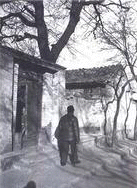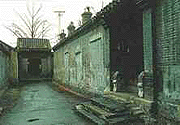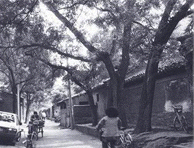(In 3 parts)
Our next outing was to one of Beijing's many hutongs but before we get to our photos here is a little background.
Our next outing was to one of Beijing's many hutongs but before we get to our photos here is a little background.
Beijing's Hutongs
Kublai Khan |
Hutongs first came into existence during the Yuan Dynasty (1271-1368) when Kublai Khan (first emperor of the Yuan Dynasty) founded Beijing as the capital. In the residential area, all closed courtyards were built in a neat orderly layout, and hutongs served the purpose of going around. During that period, hutongs were all 9.3 meters (30.5 feet) in width which let the sunshine in all the year round. In the later dynasties, small ones were formed within the existing hutongs, as a result, hutongs now vary in width and length and some even have many turnings.
The word hutong came from the Mongolian language about 700 years ago. The original Mongolian word was hottog, meaning " water well." It means a place where people live, because people always gather where there is water. Today in Beijing, the word hutong means a small alleyway or lane. They are typical of the old part of Beijing and are formed by lines of siheyuan (Chinese: 四合院; pinyin: sìhéyuàn) a compound made up of rooms around a courtyard in which most Beijing residents used to live.
Siheyuan model |
In old China, there were clear definitions of what was a street and what was a lane. A 36-metre-wide road was called a big street and an 18-metre-wide road was called a small street. A 9-metre-wide lane was called a hutong. Of course, not all hutongs follow the straight and narrow. There are also slant hutongs, half hutongs and blind hutongs. Beijing's shortest hutong is just 10 metres long and the narrowest is only about 40 centimetres wide. Some hutongs have more than 20 turns. As such, they are often a maze through which it is fascinating to wander, as long as you're not afraid of getting lost.
The Qianshi Hutong in the Qinamen Area is only 40 centimeters (16 inches) at its narrowest. This is the narrowest hutong of Beijing and would certainly pose a challenge for a plump person or two persons headed in opposite directions. The Jiudaowan Hutong has more than twenty turns, even the locals can get lost there, let alone foreigners. Even if you have a very good sense of directions, you still might not be able to manage without checking the signposts.
Most hutongs run east to west or from the north to south this is because most siheyuan were built along such axes according to the rules of feng shui. This formula created the neat layout of the city. In order to allow the main house to get more sunshine and resist cold winds from the north the courtyards lined alongside the hutongs were all built facing south, so hutongs running east to west are superior in number. But there are also some hutongs that are off 'the grid' which leaves their courtyards always overshadowed.
Hutong has become a general name for all the lanes and streets in Beijing. Recent record shows that there are over 6,000 hutongs and that alleys with a name of such-and-such Hutong have reached 1,300 or so. The ancient hutong area takes up most of the urban district where one third of the people living in the urban area reside. The residents there retain their old way of life and deem hutongs as their indispensable part of Beijing culture.
In many people's minds, Beijing is associated with the hutongs. They are an important part of the culture and way of life of Beijingers, especially the older generation.
Walking through the hutongs, it is common to see groups of elderly citizens sitting together playing cards, mahjong or Chinese chess. In the early mornings and evenings, they gather to practice traditional forms of exercise such as taijiquan as well as to dance and sing folk songs or Peking Opera arias. Also important to hutong life is the traditional foods being sold in carts or small stalls. These change according to the season, from flavoured ice in the summer to long kebabs of crab apples covered in sugar in the autumn and winter.
So imporant are the hutongs to the culture of Beijing that there have been many operas, plays and films about them. Lao She (1899 - 1966), one of 20th century China's greatest novelists and playwrights, is responsible for one such homily. His "Teahouse" is set in what is often the focal point of a hutong community and brings together several characters from the old streets of Beijing to discuss the problems of traditional society. A more modern love song for the hutongs is Zhang Yang's "Shower" (1999) about a tradtional bath house where men from the community gather to drink tea, receive massages, fight crickets and escape their marital problems. The film laments the loss of such old ways of life as the hutongs are being knocked down to make way for modern blocks of flats.
History
 According to historical records, there was already a small city on the site of present-day Beijing 3,000 years ago. It was in the 12th century during the Jin Dynasty (1115 - 1234) that Beijing became a capital city for the first time. At that time, there were no hutongs in Beijing, just streets and roads. Hutongs first appeared in the Yuan Dynasty (1271-1368) after the original city was destroyed during a war. Most of the hutongs still in existence today date from the Ming (1368 - 1644) and Qing (1644 - 1911) dynasties. It is, however, still possible to find some from the Yuan Dynasty. For instance, the Zhuanta Hutong on Xisi in the west of the city is one such ancient hutong. In dramas written during the Yuan period, the Zhuanta Hutong is often mentioned. The area was also the home of famous playwright Guan Hanqing, China's Shakespeare of the Yuan Dynasty.
According to historical records, there was already a small city on the site of present-day Beijing 3,000 years ago. It was in the 12th century during the Jin Dynasty (1115 - 1234) that Beijing became a capital city for the first time. At that time, there were no hutongs in Beijing, just streets and roads. Hutongs first appeared in the Yuan Dynasty (1271-1368) after the original city was destroyed during a war. Most of the hutongs still in existence today date from the Ming (1368 - 1644) and Qing (1644 - 1911) dynasties. It is, however, still possible to find some from the Yuan Dynasty. For instance, the Zhuanta Hutong on Xisi in the west of the city is one such ancient hutong. In dramas written during the Yuan period, the Zhuanta Hutong is often mentioned. The area was also the home of famous playwright Guan Hanqing, China's Shakespeare of the Yuan Dynasty.Many hutongs have a story behind them. Near the Forbidden City in the heart of old Beijing is a hutong called "the Weaving Girl" named after the daughter of a god who descended to the human world with her sisters to swim in a river and then proceeded to fall in love with a cowherd. Her enraged father, the Celestial Emperor, took the girl back and separated the couple with the Milky Way. On the opposite side of the Forbidden City, there used to be a Cowherd Bridge. Flanked by the cowherd and the weaving girl, the suggestion was that the feudal emperors living in the Forbidden City were the sons of Heaven.
Beijing's hutongs are more than just architecture. They are the people who live there. They are a museum of Beijing's folk custom and they are a witness to the city's history.
Well OK, history and background out of the way...our hutong visit started with a rickshaw ride. I'm not a huge and fat as I appear to be in the photo below. The rickshaw is small and mom/granny is only 4 foot 8 inches...it's an optical illusion (at least that's my story and I'm sticking to it). Actually, I gained a butt load (literally) after my bout with cancer. Since we returned from the trip I have lost about 20 lbs., honest. At any rate, we all piled in to our respecticve rickshaws and our drivers took our pictures.
We in turn took their pictures, these guys were our various drivers.
These girls were amused by Granny's Panda hat.
(continued next post)


























No comments:
Post a Comment